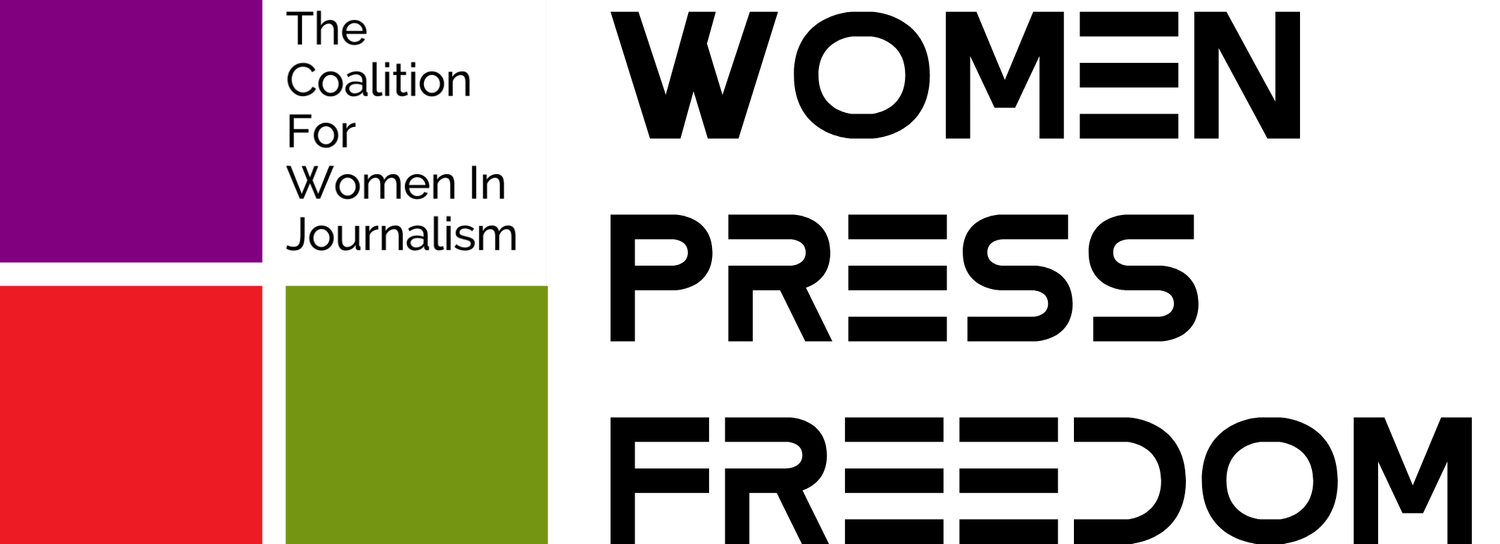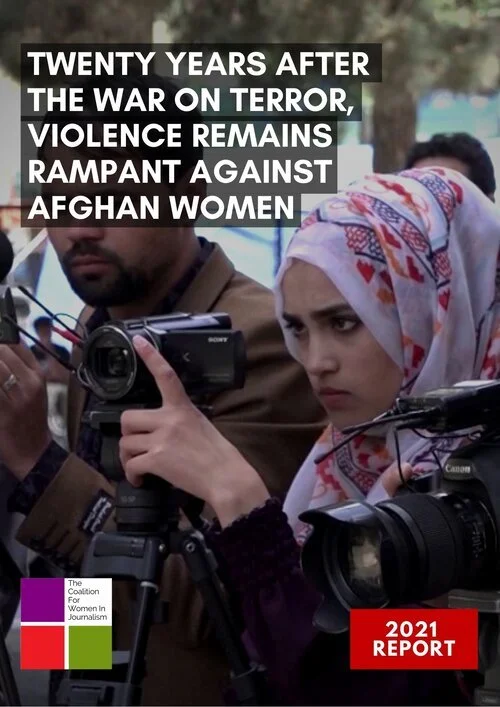Twenty Years After The War on Terror, Violence Remains Rampant Against Afghan Women
In 2001, as the world witnessed the initiation of a war that appears to never end, then First Lady Laura Bush famously justified the American invasion of Afghanistan with the promise of a better life for women oppressed under the Taliban regime. “Because of our recent military gains, in much of Afghanistan women are no longer imprisoned in their homes,” she said in a radio address on November 17, 2001.
Twenty years later, as President Joe Biden announces the withdrawal of American troops from the region, Afghanistan remains one of the most dangerous places for women journalists to operate. Women journalists have historically become either “collateral damage” in US imperialistic ambitions or soft targets for the militants operating in the region who regularly frame them as “western” agents. In either case, far from being “liberated” as Laura Bush had promised twenty years ago, women journalists have become vulnerable to attack on two fronts. Attacks have only accelerated following the agreement between the US state and the leadership of the Afghan Taliban, with several women journalists being murdered in broad daylight by rogue extremist militant wings.
The Coalition For Women In Journalism thoroughly recorded the ongoing violence in the country even as international powers have remained silent and let the injustices unfold. Women journalists in Afghanistan continue to play an immensely important role in a country that has seen extreme political instability in recent years, despite a direct threat to their life. In times like these, it becomes the moral duty of international watchdogs and those in power to amplify their voices. The empowerment of Afghan women relies on alliance, not invasion.
CFWIJ repeatedly spoke out about the killings of Afghan women journalists
On May 11 2019, the murder of Mina Mangal sent shockwaves across the region. Mina had been working as the parliamentary adviser to the Afghan government, a job she took after spending a big chunk of her career as a prominent TV presenter for Pashto-language channels. Having sounded several warnings regarding the threats she was receiving, Mangal was gunned down in broad daylight, and the family alleged, her conservative ex-husband who did not approve of her feminist politics was behind the attack. They accused the security agencies of being lax in their duties, after their inability to protect Mangal despite the several complaints of threats she had registered with them.
Things continued to become more harrowing, when more than a year and a half later, Malalai Maiwand was killed on the streets of Jalalabad. On December 10 2020, Human Rights Day, anchor on Enikas Radio and TV in Afghanistan, Maiwand was murdered alongside her driver Mohammad Tahir. Gunmen, whom the Islamic State eventually claimed, fired on Maiwand’s vehicle, killing both the passengers inside it. Maiwand’s mother, who was an activist as well, had lost her life to unidentified attackers five years prior.
Less than three months after Malalai’s murder, three women journalists were killed in broad daylight, again in Jalalabad. Mursal Wahidi, Sadia Sadat, and Shahnaz Roafi, who were also working with y Enikass Radio and TV, were targeted in two different attacks on March 2 2021. According to reports, attackers shot Saadat and Raofi who were on their way home. Later, at a different location Wahidi was shot as well. While the law enforcement agencies took a suspect in custody, they did not give out an official statement at the time. On the other hand, the Islamic State terror group’s regional affiliate, IS Khorasan Province, claimed responsibility for the attack. Loved ones admit that they do not believe that the law enforcement agencies in the country would be able to bring the perpetrators to justice.
On June 4, 2021, Mina Kheiri, journalist and media worker for Ariana Radio and Television was murdered at seven in the evening in an IED attack in Kabul at Pul-e-Sokhta area. Her mother reportedly died in the same attack, and her sister sustained serious injuries for which she is being medically treated. According to a source at Ariana News, the family was out shopping when the incident took place. She is the fourth Afghan journalist to be killed in 2021 at the time this report was published, raising alarm on the dangers the Afghan journalist community, especially women journalists, are being forced to confront.
CFWIJ is extremely concerned about the lack of support for women journalists in the country
Women journalists have been on the receiving end of threats by militant organizations resulting in either them leaving the country or downsizing their work. Farahnaz Forotan is a political presenter who relocated to France after repeated threats to her security. Fatemeh Hashim, chief editor of Khaama Press also left the country, citing that Kabul is a city of terror for journalists. Nazifa Mahbobi who worked for Radio Free Europe from Afghanistan was forced to go into hiding after an attack on her home. Photojournalist Mariam Alimi who has been active since 2006, is also currently seeking asylum due to the risks she faces in Afghanistan.
Those left behind continue to face severe danger and sinister attempts to silence them. Fatima Roshanian, an editor for the feminist magazine Nimorkh Weekly, had to resort to working from her home after she was identified by militant networks in the country. Roshanian’s name appeared on a “kill list” that was circulated on social media, indicating the risks her visibility had brought to her door. Roshanian claims that everyone knows who is behind these threats and the aim is to silence voices of dissent in the country.
The widespread attacks on women journalists and repeated threats have forced them to roll back their operations. Journalist Sahira Saleem quit her job following the murders of Wahidi, Sadat, and Roafi. Similarly, journalists Alias Razia, who is only 24 years old also chose to leave her workplace after she witnessed an attack on women polio vaccinators in the same city. Their fears are not unfounded; Zabiullah Farhang, an official at the Afghanistan Independent Human Rights Commission, attested, “14 women have been killed and 22 others wounded since the start of 2021.” Of these 14 women, seven were killed last month in Jalalabad.
Despite the threats women already face the Afghan state is an unspeaking viewer at best, and complicit in the violence at worst. On November 5 2020, the Afghan police illegally raided the house of photojournalist Tahereh Rezaei. During the raid, for which the agency had no search warrant, they seized the properties of those inside the house, cut off their cellular and internet connectivity and physically assaulted one of them for questioning the legitimacy of their actions. When Rezaei took to Twitter to report the incident, the Afghan Vice President Amrullah Saleh threatened the journalist claiming she was telling a lie. The Minister of Interior also dismissed the need for a search warrant during such incidents.
CFWIJ stands in solidarity with Afghan women journalists striving to keep hope alive
Even as it has become clearer than ever the sheer magnitude of the dangers that Afghan women journalists face, they continue to undertake immense responsibility to work for a more just, more peaceful future for the country.
In June 2020, journalist Anisa Shaheed was recognized by Reporters Without Borders for her “courageous” reporting on the coronavirus pandemic. Shaheed was listed in a group of 30 international “information heroes” -- journalists, whistleblowers and media outlets-- whose "courage, perseverance or capacity to innovate has helped to circulate reliable and vital information during the Covid-19 pandemic."
Journalist Neda Sadeq Oghlo, too, emerged as a symbol of resistance in Afghanistan. Neda recently established her own radio channel as she believes that this is the time for civil society to actively work towards peace, and the media industry is one of the avenues she trusts to make a difference. Even though the channel is only two years old, Neda believes in its potential to spread a message of peace amongst the Afghan population who have suffered the senseless violence of the War on Terror. The channel employs 20 workers, eight of whom are women, and broadcasts music, news, and entertainment programs.
The Coalition For Women In Journalism urges the international community to extend support to the women journalists from Afghanistan who are bravely reclaiming their space in a country that has routinely been subjected to conservative political tides. It will do well for us to remember that women journalists are active agents of their own politics - they are not vehicles for political ideologies of powers with vested interests in the region, whether they be imperialistic ventures of religious extremism. At this time, the Afghan women journalists require a progressive, feminist alliance in order to empower themselves, and we are proud to stand in solidarity with their unwavering voices.
If you would like to request more insight into our findings, or would like to suggest an addition to our work reach out to us at data@womeninjournalism.org. For media inquiries reach out to us at press@womeninjournalism.org.
